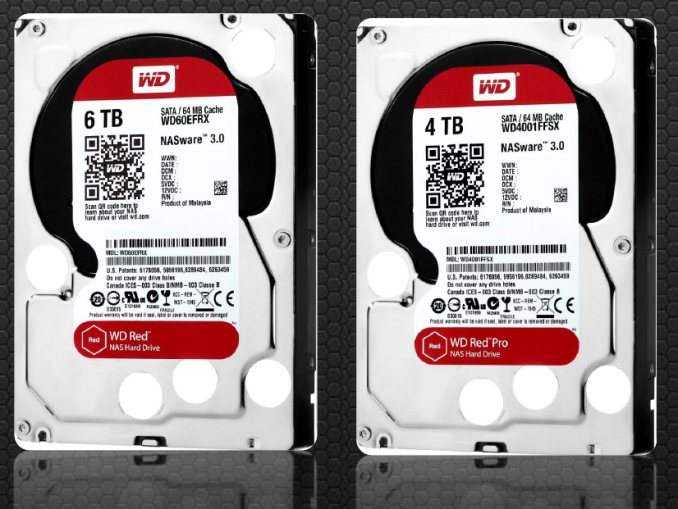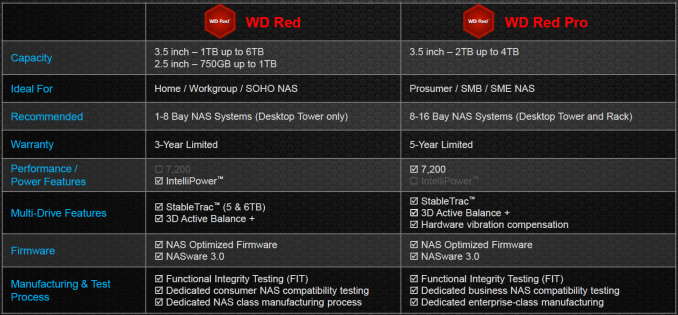Western Digital Updates Red NAS Drive Lineup with 6 TB and Pro Versions
by Ganesh T S on July 21, 2014 8:00 AM EST- Posted in
- NAS
- Storage
- Western Digital

Back in July 2012, Western Digital began the trend of hard drive manufacturers bringing out dedicated units for the burgeoning NAS market with the 3.5" Red hard drive lineup. They specifically catered to units having 1-5 bays. The firmware was tuned for 24x7 operation in SOHO and consumer NAS units. 1 TB, 2 TB and 3 TB versions were made available at launch. Later, Seagate also jumped into the fray with a hard drive series carrying similar firmware features. Their differentiating aspect was the availability of a 4 TB version. Western Digital responded in September 2013 with their own 4 TB version (as well as a 2.5" lineup in capacities up to 1 TB).
Today, Western Digital is making updates to their Red lineup for the third straight year in a row. The Red lineup gets the following updates:
- New capacities (5 TB and 6 TB versions)
- New firmware (NASware 3.0)
- Official sanction for use in 1-8 bay tower form factor NAS units
In addition, a new category is also being introduced, the Red Pro. Available in 2 - 4 TB capacities, this is targeted towards rackmount units with 8 - 16 bays (though nothing precludes it from use in tower form factor units with lower number of bays).
WD Red Updates
Even though 6 TB drives have been around (HGST introduced the Helium drives last November, while Seagate has been shipping Enterprise Capacity and Desktop HDD 6 TB versions for a few months now), Western Digital is the first to claim a NAS-specific 6 TB drive. The updated firmware (NASware 3.0) puts in some features related to vibration compensation, which allows the Red drives to now be used in 1 - 8 bay desktop NAS systems (earlier versions were officially sanctioned only for 1 - 5 bay units). NASware 3.0 also has some new features to help with data integrity protection in case of power loss. The unfortunate aspect here is that units with NASware 2.0 can't be upgraded to NASware 3.0 (since NASware 3.0 requires some recalibration of internal components that can only be done in the factory).
The 6 TB version of the WD Red has 5 platters, which makes it the first drive we have seen to have an areal density of more than 1 TB/platter (1.2 TB/platter in this case). This areal density increase is achieved using the plain old Perpendicular Magnetic Recording (PMR) technology. Western Digital has not yet found reason to move to any of the new technologies such as SMR (Shingled Magnetic Recording), HAMR (Heat-assisted Magnetic Recording) or Helium-filling for the WD Red lineup.The 5 TB and 6 TB versions also have WD's StableTrac technology (securing of the motor shaft at both ends in order to minimize vibration). As usual, the drive comes with a 3 year warranty. Other aspects such as the rotation speed, buffer capacity and qualification process remain the same as that of the previous generation units.
WD Red Pro
The Red Pro targets medium and large business NAS systems which require more performance by moving to a rotation speed of 7200 rpm. Like the enterprise drives, the Red Pro comes with hardware-assisted vibration compensation, undergoes extended thermal burn-in testing and carries a 5-year warranty. 2, 3 and 4 TB versions are available, with the 4 TB version being a five platter design (800 GB/platter).
The WD Green drives are also getting a capacity boost to 5 TB and 6 TB. WD also specifically mentioned that their in-house NAS and DAS units (My Cloud EX2 / EX4, My Book Duo etc.) are also getting new models with these higher capacity drives pre-installed. The MSRPs for the newly introduced drives are provided below
| WD Red Lineup 2014 Updates - Manufacturer Suggested Retail Prices | ||
| Model | Model Number | Price (USD) |
| WD Red - 5 TB | WD50EFRX | $249 |
| WD Red - 6 TB | WD60EFRX | $299 |
| WD Red Pro - 2 TB | WD2001FFSX | $159 |
| WD Red Pro - 3 TB | WD3001FFSX | $199 |
| WD Red Pro - 4 TB | WD4001FFSX | $259 |
We do have review units of both the 6 TB WD Red and the 4 TB WD Red Pro. Look out for the hands-on coverage in the reviews section over the next couple of weeks.











37 Comments
View All Comments
JimmyWoodser - Friday, August 1, 2014 - link
Hi, I am about to buy my first NAS and looking at DS415play and was wondering which 4TB drive to put in? I think I want two 4TB in RAID 1. I was thinking WD red but wondered if the red pro is worth the premium? Thanks JimS.D.Leary - Monday, July 21, 2014 - link
Anyone have an idea why they haven't updated the 2.5" drives other than firmware? They obviously can pack more on a platter, but the 2.5 Reds have been stuck in limbo for a while. At this point I would have expected them to be somewhere between two and three TB.SDLeary
DanNeely - Monday, July 21, 2014 - link
The only time a (laptop thickness) 2.5" drive would get that close to the max capacity of a 3.5" drive is when the latter is being held back for a long time. 2.5" platters can only hold about half the data of a 3.5" platter, and unless you go to the extra thick drives in some storage enclosures you're limited to 2 platters. With everyone limited to a 1tb platter in 3.5" drives until today, that meant they were also limited to 500gb platters in 2.5" drives and a 1tb maximum capacity as a result. We'll probably see 600gb/1.2tb (640/1.25?) 2.5" drives in the near future as WD upgrades more of its production line.Dahak - Monday, July 21, 2014 - link
well someone is building 1.2tb 2.5 inch drives, as we deal with hp servers alot and they do have them available. usually seagate or hitachi builds themhttp://h30094.www3.hp.com/product/sku/10745146
ZeDestructor - Monday, July 21, 2014 - link
That's a 10k RPM SAS drive. They come in a 3.5" form factor, so they can put in 5 platters into a single disk relatively easily. 2.5" 9mm drives on the other hand is where the problem lies.Adul - Tuesday, July 22, 2014 - link
It still is a 1.2 TB 2.5" drive1.2TB 6G SAS 10K rpm SFF (2.5-inch) SC Dual Port ENT 3yr Warranty Hard Drive
Also hitachi has 2.5" 1.8 TB 10K SAS drives
http://www.hgst.com/hard-drives/enterprise-hard-dr...
ZeDestructor - Tuesday, July 22, 2014 - link
The issue is still the number of platters: at 15mm high, the 1.8TB drive uses 4 platters, which divides nicely to 450GB per platter, about on track with what is seen in the 2.5" 9.5mm segment.At 12mm high, you can fit 3 platters, at 9.5mm high 2, at 7mm 1 and at 5mm, thanks to some very clever PCB work, 1 full double-sided platter. HGST is a bit of a trailblazer here, with 3 platters in 2.5" 9.5mm, but it's HGST, and they've more often than not been the leaders in density for a very long time
Given the current 500GB/platter capacity, it will take a while for things to move forward, although given the previous 500:800GB ratio, we should see 750GB platters soon-ish